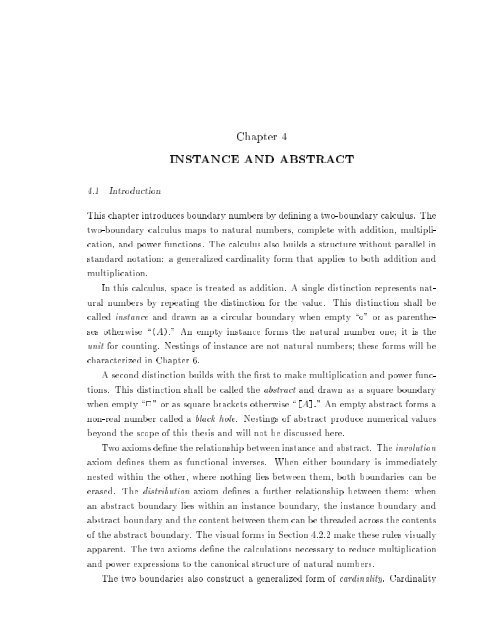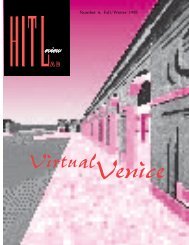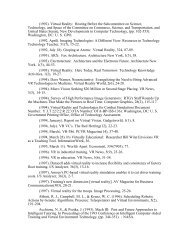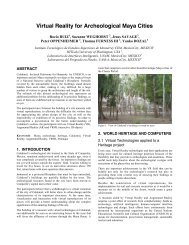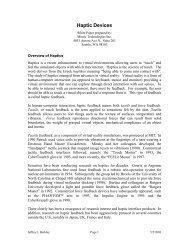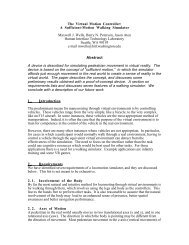A Calculus of Number Based on Spatial Forms - University of ...
A Calculus of Number Based on Spatial Forms - University of ...
A Calculus of Number Based on Spatial Forms - University of ...
You also want an ePaper? Increase the reach of your titles
YUMPU automatically turns print PDFs into web optimized ePapers that Google loves.
Chapter 4<br />
INSTANCE AND ABSTRACT<br />
4.1 Introducti<strong>on</strong><br />
This chapter introduces boundary numbers by dening a two-boundary calculus. The<br />
two-boundary calculus maps to natural numbers, complete with additi<strong>on</strong>, multiplicati<strong>on</strong>,<br />
and power functi<strong>on</strong>s. The calculus also builds a structure without parallel in<br />
standard notati<strong>on</strong>: a generalized cardinality form that applies to both additi<strong>on</strong> and<br />
multiplicati<strong>on</strong>.<br />
In this calculus, space is treated as additi<strong>on</strong>. A single distincti<strong>on</strong> represents natural<br />
numbers by repeating the distincti<strong>on</strong> for the value. This distincti<strong>on</strong> shall be<br />
called instance and drawn as a circular boundary when empty \" or as parentheses<br />
otherwise \(A):" An empty instance forms the natural number <strong>on</strong>e; it is the<br />
unit for counting. Nestings <str<strong>on</strong>g>of</str<strong>on</strong>g> instance are not natural numbers; these forms will be<br />
characterized in Chapter 6.<br />
A sec<strong>on</strong>d distincti<strong>on</strong> builds with the rst to make multiplicati<strong>on</strong> and power functi<strong>on</strong>s.<br />
This distincti<strong>on</strong> shall be called the abstract and drawn as a square boundary<br />
when empty \2" or as square brackets otherwise \[A]:" An empty abstract forms a<br />
n<strong>on</strong>-real number called a black hole. Nestings <str<strong>on</strong>g>of</str<strong>on</strong>g> abstract produce numerical values<br />
bey<strong>on</strong>d the scope <str<strong>on</strong>g>of</str<strong>on</strong>g> this thesis and will not be discussed here.<br />
Two axioms dene the relati<strong>on</strong>ship between instance and abstract. The involuti<strong>on</strong><br />
axiom denes them as functi<strong>on</strong>al inverses. When either boundary is immediately<br />
nested within the other, where nothing lies between them, both boundaries can be<br />
erased. The distributi<strong>on</strong> axiom denes a further relati<strong>on</strong>ship between them: when<br />
an abstract boundary lies within an instance boundary, the instance boundary and<br />
abstract boundary and the c<strong>on</strong>tentbetween them can be threaded across the c<strong>on</strong>tents<br />
<str<strong>on</strong>g>of</str<strong>on</strong>g> the abstract boundary. The visual forms in Secti<strong>on</strong> 4.2.2 make these rules visually<br />
apparent. The two axioms dene the calculati<strong>on</strong>s necessary to reduce multiplicati<strong>on</strong><br />
and power expressi<strong>on</strong>s to the can<strong>on</strong>ical structure <str<strong>on</strong>g>of</str<strong>on</strong>g> natural numbers.<br />
The two boundaries also c<strong>on</strong>struct a generalized form <str<strong>on</strong>g>of</str<strong>on</strong>g> cardinality. Cardinality


